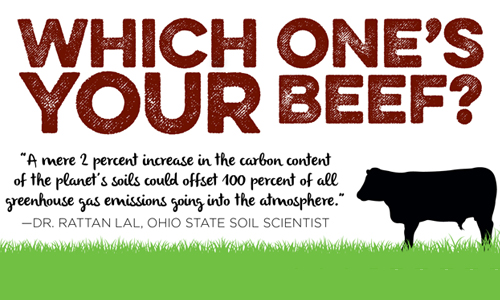

Using short rotation with solar-powered mobile fencing, a new generation of ranchers is growing grass while building carbon and organic matter into the soil. The 12-minute video Soil Carbon Cowboys featured one such “grass rancher,” Gabe Brown, who increased the organic matter in his North Dakota pastureland from less than 2 percent to 8 percent in 20 years.
[vimeo https://vimeo.com/80518559 expand=1]
For annual crops, planting rotational cover crops like vetch or alfalfa, instead of using nitrogen fertilizers, is essential. Chemical nitrogen fertilizers release massive amounts of nitric oxides that are nearly 400 times worse than carbon dioxide. Some organic CAFO producers such as Horizon Organic Milk are clearly not regenerative, as they rely on factory farms to produce a large percentage of their milk.
The U.S. Department of Agriculture and U.S. Environmental Protection Agency statistics vastly underreport agriculture emissions at 10-12 percent total. Many researchers think agriculture is the source of more of these emissions than even transportation fuels. Organic is better than conventional, but organic plus regenerative is best, for it enhances soil fertility vs. merely maintaining it. (A big reason why the return of hemp farming is so vital is hemp’s deep taproot and nitrogen-rich leaves that build soil tilth).
Yet, as Tom Newmark of regenerative farming group the Carbon Underground says, “We need to both move forward in building soil life and conduct more science around carbon sequestration to share with policymakers and allies.”
The Way Forward
Many in the organic movement wonder about our NGO allies in the climate, ocean and forestry sectors. According to Ronnie Cummins of the Organic Consumers Association, “With the mounting evidence of how regenerative organic agriculture is the number one solution for climate change, ocean health, and soil ecology via sequestering carbon, it’s time for the environmental movement to join forces. In fact, our survival depends on it.”
Trying to solve the entire problem by reducing global carbon via solar, wind and renewables has been a failure. One climate meeting after another ends with people throwing up their hands and declaring that we’re doomed because nations won’t agree to meaningful cuts. The message of drawing down carbon via regenerative agriculture warrants no mention in the glossy documents, nor even a tweet!
A recent Cummins “Letter from Lima” provides interesting background on the climate movement.
Yet a groundswell of people are beginning to realize that the way forward is to support regenerative organic farming and pasture-raised meat and dairy systems while simultaneously reducing animal consumption. As the Earth passes the 400-ppm carbon mark, noted author and environmentalist Paul Hawken declares, “Stabilization at 450, 500, 550 ppm is chaos—our goal should be drawdown.”
Which is better for the environment—to buy a Tesla and consume a standard American diet or to drive a used SUV and eat an organic diet with some pastured meat and dairy? Yes, it’s the latter, and of course even better is to eat an organic diet, walk or bike more, and drive a more energy-efficient car.
Soil, not oil, is the wise path forward. At the height of this information age of Google and the social media, the history of our planet is being written. Will it ultimately be said that the simple solution under our feet was shared around the digital campfire, and thus globally chosen by informed citizens of the Earth? Or will the annals read that this saving solution was ignored by all but a few? Did the 7 billion people on Planet Earth succumb to false messages from Monsanto, Exxon and self-serving apologists that GMO “better living through chemistry” food systems were best?
As you read this, a new generation of GMO 2.0 untested synthetic foods is being programmed in labs via “3-D food printing.” The fate of Earth’s life-support systems is hanging in the balance. Remember, as you start to reach for that box of non-organic cereal for your shopping cart: What we eat will impact the planet more than just about anything else we do. It’s late in the fourth quarter and there are no timeouts left, but—yes—we have the ball.
It’s time for us to revive the ancient wisdom of honoring the land, and in the process heal our atmosphere, our oceans, our humus-sphere and ourselves. Regenerative organic agriculture is the answer we need to create a food system that works for everyone. Are you ready to be part of this solution?
John W. Roulac, founder and CEO of the superfoods company Nutiva, has also founded five nonprofit ecological groups, including GMO Inside and the Nutiva Foundation. John has written four books, including Backyard Composting and Hemp Horizons.
YOU MIGHT ALSO LIKE
Vandana Shiva and Hummingbird Project Devoted to Saving Seeds and Restoring Soils

 233k
233k  41k
41k  Subscribe
Subscribe 